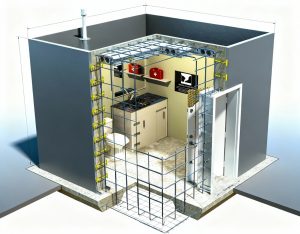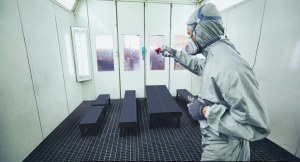Bridges remain some of the most vital components of modern infrastructure, linking communities and enabling commerce. They are also some of the most exposed structures, subjected daily to moisture, temperature swings, ultraviolet light, and heavy mechanical wear. A well-designed bridge may carry traffic for decades, but without proper surface protection, its steel and concrete can deteriorate far earlier than its intended service life. Protective coatings, particularly those formulated for high performance in demanding environments, stand at the front line of defense against this decline.
The Environment Bridges Endure
The stresses that bridges face go beyond the obvious weight of vehicles and environmental exposure. Steel components, while strong, remain vulnerable to oxidation when coatings fail. Concrete decks and supports absorb moisture, which can freeze and expand, creating cracks and weakening structural integrity. In coastal or industrial settings, salt and airborne chemicals add another layer of risk, accelerating corrosion and chemical degradation.
In many climates, seasonal cycles amplify the problem. Summer heat expands materials, while winter cold contracts them. Expansion joints help, but even small coating breaches allow water to penetrate and cause damage from within. Bridges spanning waterways often face constant humidity and splashing, while urban bridges encounter oil, fuel, and chemical runoff from vehicles. The coating system must endure all of these conditions without losing adhesion or flexibility.
Protective Coating Fundamentals
A bridge coating serves two main purposes: it isolates the structure from the surrounding environment and withstands the physical stresses of daily use. Achieving both requires careful material selection, precise application, and ongoing inspection.
Historically, coatings for steel bridges relied heavily on solvent-based paints and epoxy systems. While these offered solid protection when applied correctly, they often required multiple coats, long curing times, and extensive maintenance. Newer systems, such as polyurea and polyurethane hybrids, have improved on these limitations by providing faster cure times, seamless application, and stronger resistance to both abrasion and chemicals.
Polyurea, in particular, has drawn attention for its ability to form a continuous membrane without seams or joints. This eliminates weak points where moisture can enter. Its fast-set chemistry allows it to cure in seconds, even in variable weather conditions, minimizing downtime for bridge traffic.
Application Challenges
Applying a protective coating to a bridge is rarely a simple task. The work must be done while managing safety concerns for both workers and the public. Bridges often remain in use during coating projects, requiring containment systems to prevent overspray or debris from falling onto roadways or waterways below.
Surface preparation plays a critical role. For steel, abrasive blasting removes existing corrosion and provides a profile that allows the coating to adhere. For concrete, shot blasting or grinding ensures a clean surface free of laitance or weak material. Any contamination left behind can compromise the coating’s performance.
Weather adds another variable. Rain, high humidity, or extreme cold can delay work or require adjustments in coating formulation and application technique. The choice of coating often depends on the environmental conditions during the project, as some materials cure best in specific temperature and humidity ranges.
Longevity and Maintenance
A well-applied bridge coating system can last many years, but no system is entirely maintenance-free. Inspections should identify damage from impacts, abrasion, or localized corrosion. Small failures can be repaired before they grow into larger issues requiring extensive rework.
The service life of a coating system depends on both the quality of the initial application and the stresses the bridge faces. In some high-exposure environments, even the best systems may need touch-ups within a decade. In others, they can perform effectively for much longer. The cost of these periodic maintenance cycles remains far lower than the expense of replacing structural elements.
Advancements in Bridge Coating Technology
Over the last decade, coating manufacturers have focused on improving both the durability and the environmental profile of their products. High-solids and solvent-free formulations reduce emissions during application. Polyurea systems can now be tailored to specific performance needs, such as increased UV stability for exposed surfaces or greater flexibility for expansion joints.
Technologies like moisture-tolerant primers have expanded the application window, allowing coating work to proceed in less-than-ideal conditions without compromising adhesion. Advances in spray equipment make it possible to apply thick films in a single pass, reducing labor time and improving uniformity.
Some bridge owners have also begun integrating smart coating technologies—systems embedded with sensors to monitor temperature, strain, or corrosion activity. While still in the early stages of deployment, these could change how maintenance is planned, allowing intervention before visible damage appears.
Why Protective Coatings Matter
The lifespan of a bridge is tied directly to the protection of its underlying materials. Without a barrier against the environment, corrosion and weathering work steadily, reducing structural capacity and increasing the likelihood of costly repairs. Coatings act as that barrier, transforming maintenance from an unpredictable emergency into a scheduled, manageable process.
The choice of coating material and application method reflects both engineering needs and budget realities. While initial costs for advanced systems like polyurea may be higher than traditional paints, the reduced downtime, longer intervals between maintenance, and superior protection can provide significant long-term savings.
Looking Ahead
Bridge rehabilitation technology continues to evolve, driven by advances in chemistry, application equipment, and monitoring systems. As infrastructure budgets tighten and the demand for longer service life grows, these coatings will play an even greater role in ensuring bridges remain safe and operational.
Whether protecting a small rural overpass or a major suspension bridge, the principle remains the same: a strong, durable coating system is one of the most effective tools available to preserve structural integrity. In this way, bridge coatings are not just about paint or membrane thickness—they are about extending the life of infrastructure that millions of people depend on every day.






